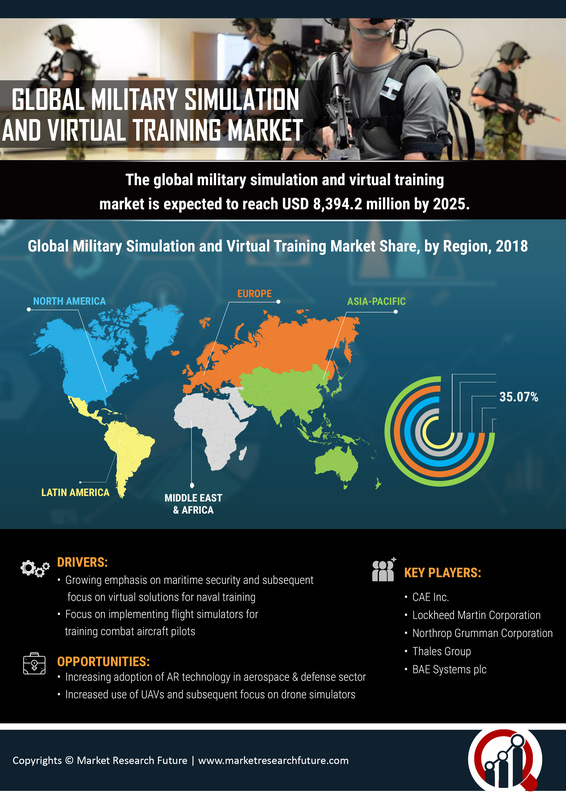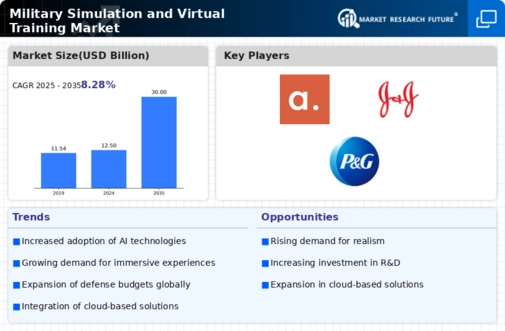Market Growth Projections
The Global Military Simulation and Virtual Training Market Industry is projected to experience substantial growth over the coming years. With an estimated market value of 12.5 USD Billion in 2024, the industry is expected to expand significantly, reaching approximately 30 USD Billion by 2035. This growth trajectory indicates a compound annual growth rate of 8.28% from 2025 to 2035. The increasing emphasis on advanced training methodologies, coupled with technological innovations, is likely to drive this expansion. As military organizations worldwide continue to prioritize effective training solutions, the market is poised for robust development in the foreseeable future.
Increasing Defense Budgets
The Global Military Simulation and Virtual Training Market Industry is experiencing growth driven by rising defense budgets across various nations. Countries are increasingly allocating substantial financial resources to enhance their military capabilities, with a projected market value of 12.5 USD Billion in 2024. This trend is particularly evident in regions such as North America and Asia-Pacific, where governments prioritize advanced training solutions to ensure operational readiness. The emphasis on modernization and technological advancements in military training is likely to propel the market further, as nations seek to adopt innovative simulation technologies to improve training efficiency and effectiveness.
Technological Advancements
Technological advancements play a pivotal role in shaping the Global Military Simulation and Virtual Training Market Industry. Innovations in virtual reality, augmented reality, and artificial intelligence are transforming traditional training methodologies. These technologies enable immersive training experiences that enhance learning outcomes and operational preparedness. For instance, the integration of AI-driven analytics allows for real-time performance assessments, thereby optimizing training programs. As the market evolves, the adoption of these cutting-edge technologies is expected to drive significant growth, with projections indicating a market expansion to 30 USD Billion by 2035, reflecting a compound annual growth rate of 8.28% from 2025 to 2035.
Focus on Enhanced Operational Readiness
Enhanced operational readiness remains a critical focus for military organizations worldwide, driving growth in the Global Military Simulation and Virtual Training Market Industry. As geopolitical tensions rise, nations are compelled to ensure their forces are adequately prepared for diverse operational scenarios. Simulation-based training allows for the replication of complex environments and situations, enabling troops to develop essential skills and decision-making capabilities. This focus on readiness is likely to result in increased investments in simulation technologies, further propelling market growth. The emphasis on operational effectiveness underscores the importance of advanced training solutions in maintaining national security.
Rising Adoption of Joint and Coalition Training
The Global Military Simulation and Virtual Training Market Industry is increasingly influenced by the rising adoption of joint and coalition training among allied forces. Collaborative training exercises enhance interoperability and coordination among multinational military units, which is essential for modern warfare. Simulation technologies facilitate these joint training initiatives by providing a shared virtual environment where forces can practice together, regardless of geographical constraints. This trend is likely to foster greater collaboration and integration among allied nations, thereby driving demand for advanced simulation solutions. The market's evolution in this context reflects the growing recognition of the importance of joint training in contemporary military operations.
Growing Demand for Cost-Effective Training Solutions
The Global Military Simulation and Virtual Training Market Industry is witnessing a surge in demand for cost-effective training solutions. Traditional training methods often incur high expenses related to logistics, personnel, and equipment. In contrast, simulation-based training offers a more economical alternative, allowing military organizations to conduct realistic training scenarios without the associated costs of live exercises. This shift towards virtual training solutions is particularly relevant in light of budget constraints faced by many defense organizations. As a result, the market is likely to see increased investment in simulation technologies that provide high-quality training while optimizing resource allocation.




